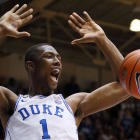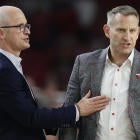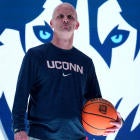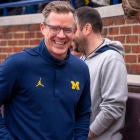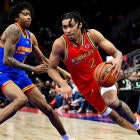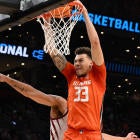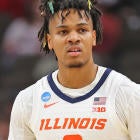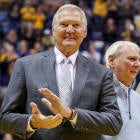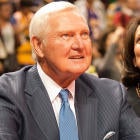DURHAM, N.C. -- Ask his coaches, friends and former teammates, they’ll all tell you Harry Giles is one of the best kids, most optimistic people you’ll come across in basketball. His positive attitude is infectious; his teams have been so good because his basketball ability effortlessly links up with a cheery, humble attitude.
But in a recent interview with CBS Sports, Giles revealed the mental struggles he’s endured since getting to Duke. For the first time in his life, basketball and all that came with it wasn’t fun. He had doubts, and they weren’t just tied to his ever-lingering knee problems. He was forced to decide between playing college basketball or sitting out the season and declaring for the 2017 NBA Draft, a choice he never really wanted to be presented with in the first place.
“This year I had times where I let the game drain me,” Giles said. “I wasn’t really having fun with it. With all this rehab, (you) hear everybody talking about you and stuff, and I got caught into that at times. I can’t even lie. It was tough.”
The tale of Giles has quickly developed a mythical aura. Though he’s still just 18, people already talk about who he once was, as if that person and player no longer exists. But maybe that’s true. For many, he was one of the most seamlessly dominant prospects to come along in a decade. He was the top-ranked recruit who looked to be the next coming of Chris Webber, a dominant athlete with the proportional skill and acumen of a young Kevin Garnett. Whereas he used to be compared to NBA greats, now he’s compared to a younger, better version of himself.
“I can’t even lie and say it’s not tough, but I can understand why people would say things about me or come at me,” Giles said. “For me not to have a good game and (have) looked like the way I did before, it’s like, what happened? He looks completely different. I can understand that.”
Giles suffered two ACL injuries in his high school career, which cost him two seasons, years he’ll never get back. He hates that.
Then, last summer, he had some discomfort in his right knee that wouldn’t go away. By October, the pain was too troublesome. A scope was required to remove loose cartilage. Because of the surgery, a heedful plan of return kept him off the floor for Duke this season until just before Christmas.
A delayed debut has turned into an understated campaign. Giles is averaging 5.0 points and 4.3 rebounds in 12.5 minutes off the bench. When he committed to Duke in 2015, the vision was Giles would be the team’s most talented player. Now he’s behind breakout sophomore Luke Kennard, junior dynamo Grayson Allen, stud freshman Jayson Tatum, unanticipated fifth-year senior standout Amile Jefferson, ultra-reliable Matt Jones and fledgling freshman Frank Jackson on the depth chart. College basketball’s waiting for Duke to become this behemoth this season, with a sense that cannot happen until the real Harry Giles shows up -- but there’s no indication that’s ever going to happen.
“You’re feeling the team’s expectations and the expectations of yourself at the same time, trying to put them together,” Giles said. “I needed to start having fun with the game again. I had so much going on with getting hurt the first time, and then getting hurt again. You get scared sometimes. I put so much into it, you get nervous like, should I do it again? To have this taken away again? I started letting it drain me.”
The left-knee scope presented Giles with an out if he wanted it. He had some people presenting him the case to never play in college.
“With the scope happening, it was like, do you really want to play now, risk it?” Giles said. “Every day was tough. It was a tough period for me, physically, emotionally, get it all together and put it all together. Do I play? You’ve got a lot of people telling you this, a lot of people telling you that. Strong candidates on both sides.”
He went through a short period not knowing where to take his next steps. Giles said his dad, who has been an integral part of his basketball recruitment and upbringing, did not tell him what to do. Father wanted son to make his own decision and live with it.
“What do I do?” Giles said, talking back through the conversations he had with his parents, his coaches, even himself. “Because I really don’t know what to do. I’ve never been in this situation before. I never played in college. But at the same time, I feel like sitting out was like, am I doing it for the money? Doing it for this, doing it for that. When I envision my dreams, it wasn’t to sit out and miss another season of basketball. I’m looking at it like, I only played two years in high school. I can’t can’t miss another season. I can’t really afford that, especially at Duke, and it’s college. Stay one year, two years, you don’t know how long it is. Can’t just sit out and let it blow by.”

“Personally, I knew I had to get playing eventually because I had to get comfortable one day,” Giles said. “I had to get back to playing with contact and the only way to do that is to play. With practice time, we had people hurt, and we didn’t have a full team. It’s fast-paced and I can’t blame them for trying to ease me in but at the same time you need to make sure the team is up to beat too. So I had to make that decision, ‘OK, What am I going to do? Am I going to go out and give this a shot or not?’”
Giles also said the only reason he wouldn’t have played is to not get hurt again. And that would’ve been a decision based on fear, which he refuses to bring with him onto the floor.
Mike Krzyzewski and his staff did not pressure him one way or the other, Giles said. They presented advice and all the options. Giles’ decision to suit up was based in good part on not wanting to feel like he was “using the program” and getting a scholarship but skating by with not playing, effectively only using the school as a stop-over. It’s taken Giles longer than he wanted, or expected, to get into true game shape, to feel comfortable on the floor and in the offense.
“The inner me, I want to prove everyone wrong,” Giles said. “Give this a shot. Do it for the love, that’s why I did it. Just to play. I know I’m struggling and stuff, but at the same time I’m going to get better. I just had to do it. I had to.”
He’s now presented with an interesting dilemma. The season’s not yet over, but Giles has gone from being a once-upon-a-time favorite to go No. 1 in the 2017 draft to becoming a player who could fall well outside the lottery. He can leave this year, get taken in the first round and make good money immediately. But if he stays, the 2018 draft class is considered weaker than 2017’s, particularly at the top. Giles could get exponentially better and be the healthy focal point on Duke’s team next season. If it happens, he’d likely parlay that into being a top-five pick -- and make more guaranteed money in the process.
But if he gets hurt again, then coming back could be for nothing. His future earnings could take a massive hit, and he’d be permanently considered damaged goods. Giles would likely be reduced to sympathetic “Greg Oden” references and comparisons. Big men sidelined by injury, tantalizing potential that was never touchd.
“I can’t let the pressure of basketball and the pressure of people’s expectation kill me,” Giles said. “You only have one time at Duke. (If) you keep carrying stuff, it will build and build and build.”
Giles fully understands his role now and doesn’t fight it. Whereas he might’ve seen himself as a burden a few months ago, the reality is he’s been low-maintenance and turned into the best complementary player in college hoops. Once he took the time to accept his part, once Giles grasped he wasn’t going to be able to transform overnight into the player he used to be, the stress and unusual unhappiness eased away.
“It worked,” he said. “Being here, it was something I needed. I’ve wondered where I’d be right now, what I’d be doing if I didn’t [choose to play]. Where would I be? How would I feel? What would I do? Also, it’s just like, how my mindset is. I was kind of going crazy. I needed to play. Sitting down was not going to cut it. Like, I don’t know how I could’ve watched [the North Carolina] game and not played.”
Giles said his physical health is not quite at 100 percent, but almost there. It’s his mental approach that’s still not all the way back. He’s been wearing a knee brace, and it’s not going to come off this season. He knows he can do a lot of things athletically that he hasn’t shown in games; he just can’t quite hit that next level in the moment. It’s his most immediate goal.
“I know that I’m healthy, I’ve just gotta tell myself to believe it at all times,” Giles said. “At times I know I can show spurts, but it’s all in choppy pieces. I just have to put it together. Instead of here and here, OK, now two in a row, and then again. Instead it’s choppy, not like how you’re used to seeing me. OK: block. OK: dunk. OK: dunk, dunk. OK: big shot, and now we’re rolling. I’m not there yet, and it’s frustrating, and I’ve got to keep working.”
Giles gives no indications on what’s coming in the spring. It is going to make for one of the biggest and most intriguing NBA Draft storylines. He got caught up in the draft speculation game way too much in October and November, and now he’s refusing to give it much attention. That all will wait until the season has settled itself.
“I just needed something to make me feel better,” Giles said. “I still have time. It’s only February and there’s still a lot season left and a lot of time left after the season, who knows.”
No one knows, and the tease of Giles’ potential hangs heavy over himself, over Duke, over what college basketball might get to see in March. Duke is now 21-5 and riding a big winning streak, and they have still have a path to a No. 1 seed. The preseason No. 1 team in the country has provided more criticism, controversy and unpredictable storylines than college basketball has seen from any one team in a very long time. The most anticipated story is the most mysterious one. For Giles, it’s a positive one -- even if few others see it that way.












